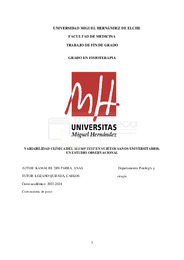Please use this identifier to cite or link to this item:
https://hdl.handle.net/11000/33608Full metadata record
| DC Field | Value | Language |
|---|---|---|
| dc.contributor.advisor | Lozano Quijada, Carlos | - |
| dc.contributor.author | Kamal El Din Parra, Anas | - |
| dc.contributor.other | Departamentos de la UMH::Patología y Cirugía | es_ES |
| dc.date.accessioned | 2024-10-22T10:54:13Z | - |
| dc.date.available | 2024-10-22T10:54:13Z | - |
| dc.date.created | 2024-06-01 | - |
| dc.identifier.uri | https://hdl.handle.net/11000/33608 | - |
| dc.description.abstract | El correcto funcionamiento del nervio depende del aporte de oxígeno y una forma de evaluarlo es por medio de los test neurodinámicos examinando la mecanosensibilidad del SNP. Uno de los test neurodinámicos más utilizados en clínica para el LBLP es el Slump test, cuyas respuestas normales han sido estudiadas en la literatura. Por eso, el propósito de este estudio es evaluar las respuestas normales y examinar el efecto del sexo, lado dominante y orden articular. Para ello, se ha realizado un estudio observacional aleatorizado sobre sujetos sanos universitarios. Un total de 38 sujetos fueron analizados de edades comprendidas entre 18 y 30 años (media 21.84 ± 2.39) en el que participaron 19 mujeres y 19 hombres. La zona dolorosa que mayor porcentaje tuvo en hombres fue el muslo no dominante (53%) seguido del glúteo (47%) y hueco poplíteo no dominante (42%); mientras que las mujeres tuvieron mayor porcentaje en el poplíteo dominante (74%), seguido de muslo dominante y no dominante, y poplíteo no dominante (63%). La intensidad de dolor fue medida por una escala numérica de dolor (NRPS) en el que se obtuvo una media para los hombres de 3.78 2.26 y para las mujeres de 3.44 2.50. No encontramos diferencias en el efecto final del lado dominante y el orden articular en la mecanosensibilidad del nervio ciático. Se requieren de futuras investigaciones en este campo con el fin de establecer la respuesta normal del Slump test. | es_ES |
| dc.description.abstract | The proper functioning of the nerve depends on the supply of oxygen, and one way to assess this functioning is through neurodynamic tests, evaluating the mechanosensitivity of the peripheral nervous system. One of the most commonly used neurodynamic tests in clinical practice for low back-related leg pain (LBLP) is the Slump test, whose normal responses have been studied. Therefore, the purpose of this study is to evaluate the normal responses and examine the effect of gender, dominant side, and joint order. To do this, a randomized observational study was conducted on healthy university subjects. A total of 38 subjects aged between 18 and 30 years (mean 21.84 ± 2.39) participated, including 19 women and 19 men. The area with the highest percentage in men was the non-dominant thigh (53%), followed by the buttock (47%) and non-dominant popliteal fossa (42%); women had a higher percentage in the dominant popliteal fossa (74%), followed by the dominant and non-dominant thigh and non-dominant popliteal fossa (63%). Pain intensity was measured using a numerical pain scale, with a mean score for men of 3.78 ± 2.26 and for women of 3.44 ± 2.50. We found no differences in the final effect of dominant side and joint order on the mechanosensitivity of the sciatic nerve. Future research is required to stablish the normal response of the Slump test. | es_ES |
| dc.format | application/pdf | es_ES |
| dc.format.extent | 25 | es_ES |
| dc.language.iso | spa | es_ES |
| dc.publisher | Universidad Miguel Hernández | es_ES |
| dc.rights | info:eu-repo/semantics/openAccess | es_ES |
| dc.rights | Attribution-NonCommercial-NoDerivatives 4.0 Internacional | * |
| dc.rights.uri | http://creativecommons.org/licenses/by-nc-nd/4.0/ | * |
| dc.subject | Slump test | es_ES |
| dc.subject | respuesta normal | es_ES |
| dc.subject | mecanosensibilidad | es_ES |
| dc.subject | pierna o lado dominante | es_ES |
| dc.subject | orden articular | es_ES |
| dc.subject.other | CDU::6 - Ciencias aplicadas | es_ES |
| dc.title | Variabilidad clínica del Slump test en sujetos sanos universitarios. Un estudio observacional | es_ES |
| dc.type | info:eu-repo/semantics/bachelorThesis | es_ES |

View/Open:
TFG KAMAL EL DIN PARRA, ANAS.pdf
1,35 MB
Adobe PDF
Share:
.png)
